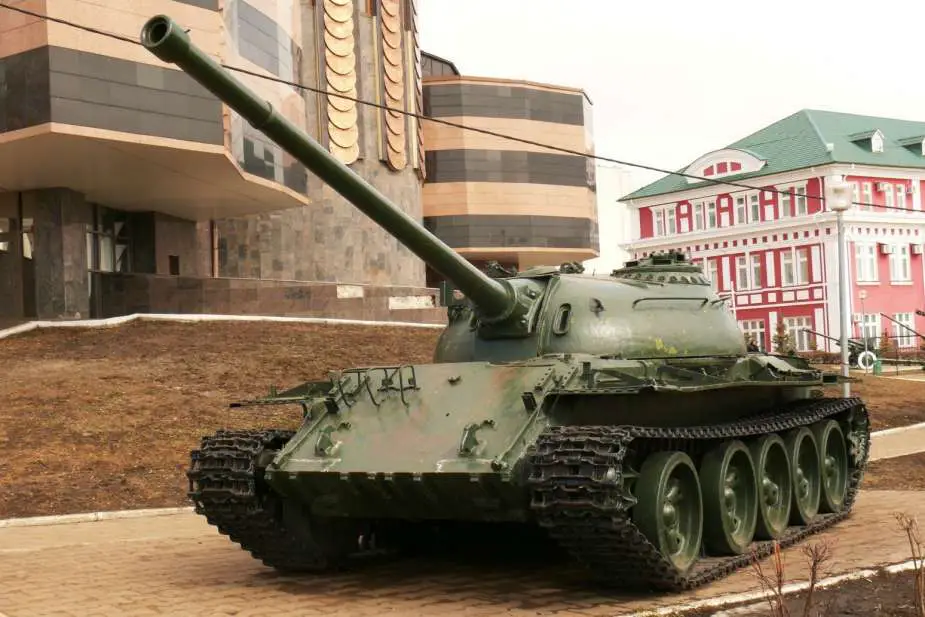Russian Army uses old Soviet T-54 tanks to attack Ukrainian troops
As reported by OSINTtechnical on February 18, 2024, Russia deployed a T-55, initially adopted into service in 1958, to attack Ukrainian positions around Robotyne. However, upon closer analysis, this T-55, distinguished by a cage but lacking ERA, was likely an older T-54, adopted in 1946, as indicated by the absence of a smoke extractor at the gun's end and the likely presence of a wind cover on the turret.
Follow Army Recognition on Google News at this link

Russia deployed a T-54, initially adopted into service in 1945, to attack Ukrainian positions around Robotyne. (Picture source: OSINTtechnical)
According to Russian media, the T-54 and T-55 tanks have been utilized in Ukraine in unconventional ways. Instead of serving as traditional battle tanks, the T-55s are primarily used as 100mm self-propelled guns, providing indirect fire support from concealed positions, akin to artillery, rather than engaging directly in offensive battlefield roles.
However, it appears that the T-55, and now even the older T-54, are being employed by Russian forces to assault Ukrainian positions, operating both as tanks and troop transports in a manner reminiscent of the Second World War. Soldiers are transported on the tanks and dismount as they near enemy lines, assuming the T-55 can reach such proximity.
The persistent use of the T-54/55 underscores questions about Russia's strategic and logistical decisions. This may reflect a scarcity of modern equipment or a deliberate tactic to preserve advanced resources for other conflict facets. It could also demonstrate a practical approach, leveraging available assets for specific purposes, thus compensating for material losses in Ukraine. Despite increased production, new material output has yet to fully offset front-line losses, prompting the utilization of older stock as a straightforward, though not necessarily efficient, solution.
Ironically, Russia's tank strategy appears to shift towards updating or deploying models more suited to a museum than a modern battlefield, such as the T-54, T-55, T-62, BTR-50, and BTR-90. Faced with significant challenges in replacing the vast numbers of lost T-72, T-80, and T-90 tanks on the Ukrainian front, Russia seems compelled to scour old depots, even graveyards, to refurbish increasingly dated tanks. These are then normally relegated to secondary roles like fire support or makeshift fortifications, echoing tactics from the Second World War.
This method may seem more cost-effective than overcoming the hurdles associated with the T-14 Armata, which has yet to achieve widespread production. It appears there's a certain pragmatic approach in revitalizing these open-air stored historical relics, offering them a second lease on life with updates, rather than confronting the complexities and expenses associated with bringing a modern tank into full-scale service.

The T-54 tank is armed with the venerable 100mm D-10T rifled gun, which can still pose a threat to lighter armored vehicles and infantry. (Picture source: Yandex)
The T-54 (GBTU Index - Object 137), a direct successor to the iconic T-34 of World War II, was first completed in Nizhny Tagil by the end of 1945 and entered Soviet service in 1946. Becoming the primary tank for the Soviet Army, armies of the Warsaw Pact countries, and many others, the T-54 saw action in various global conflicts throughout the latter 20th century, with production continuing until 1979.
Following the war, the Soviet Union pursued a more advanced tank, leading to the development of the T-54 with a new turret and 100mm rifled gun. This model underwent several modifications, including the T-54-1, T-54-2, T-54-3, T-54A and T-54B. The T-54 eventually evolved into the T-55, which was introduced into full production in 1958, featuring enhanced engine power and firing systems, and later the T-55A with comprehensive NBC protection.
The T-54/55 series, produced by the USSR and other countries, remains the most-produced tank in history, with estimates ranging from 96,500 to 100,000 units. Despite being superseded by newer models like the T-62, T-64, T-72, T-80, and T-90, these tanks continue to serve in various international armies, many updated with significant modernizations.
Throughout the Cold War, Soviet tanks, including the T-54/55, never directly engaged NATO forces in Europe. However, their presence influenced Western military development, leading the United Kingdom to develop a new tank gun, the Royal Ordnance L7, and the United States to develop the M60 tank.
The T-54 tank, a charming relic from the early era of the Cold War, still possesses some combat capabilities that can be utilized on the battlefield. The tank is armed with the venerable 100mm D-10T rifled gun, which is capable of firing armor-piercing, high-explosive, and high-explosive anti-tank rounds. Although this gun is not as powerful as modern tank cannons, it can still pose a threat to lighter armored vehicles and infantry.
The T-54 features a cast steel armor hull and turret, which provides some protection against small arms fire and artillery fragments. However, faced with the use of modern anti-tank guided missiles (ATGMs) and contemporary tank rounds, it stands about as sturdy as a tin can at a shooting range. In an attempt to stay relevant, some T-54 tanks have been upgraded with reactive armor to improve their protection against shaped-charge warheads.
Powered by a V-54 12-cylinder diesel engine, the T-54 has a top speed of around 48 km/h (30 mph) on roads and a range of approximately 500 km (310 miles). Its mobility is inferior to modern tanks but still allows for occasional tactical movements on the battlefield.
The latest variants include the T-54A which was upgraded with the addition of a new stabilization system for the 100mm D-10TG gun, allowing for more accurate firing while on the move. It also featured a new V-54 engine and an improved driver's hatch design. The T-54B received further improvements, including an upgraded gun stabilization system, night vision equipment, and an infrared searchlight for nighttime operations.



























